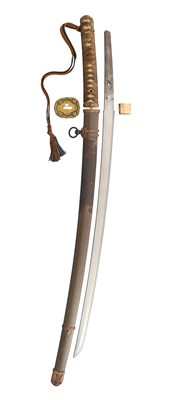Ending 21st Apr, 2024 14:00
Olympia Timed Spring 2024
7
A JAPANESE OFFICER’S SHIN-GUNTŌ (MILITARY SWORD), 1942
Sugata (configuration): shinogi-zukuri (longitudinal ridgeline) with shallow tori-zori (even curve), small kissaki (tip), gilded copper habaki (collar); hamon (tempering pattern) elegant suguha with slight notare (straight with wavy areas); kitae (forging pattern) faint itame (small wood grain); nakago (tang) ubu (unshortened) with one mekugi-ana (fixing hole), signed Koa Isshin Mantetsu kin saku (‘Asia one heart’, respectfully made from Manchurian steel) and Showa mizunoe nen haru (Spring in the horse year of the Showa period, equivalent to 1942)
Koshirae (mounting): saya (scabbard) of metal covered wood with shibabiki (reinforcing bands), ishizuke (chape), ashi (suspension ring) and standard brass and copper military fittings including the pierced tsuba (sword guard) and menuki (hilt grips) decorated with sakura (cherry blossom), wooden tsuka (hilt) with dark brown silk itō (braiding) over white samegawa (ray skin)
There has been some debate as to the meaning of Koa Isshin; some have suggested that it is a smith’s name, but it is most likely a patriotic slogan created during Japan’s imperial expansion into mainland Asia and the creation of the ‘Greater East Asia Co-Prosperity Sphere’. Manchurian steel was much favoured by the makers of military swords and blades signed Koa Isshin tend to be very well made and produced by hand; the mounts too tend to be of good quality.
Sold for £1,300
Sugata (configuration): shinogi-zukuri (longitudinal ridgeline) with shallow tori-zori (even curve), small kissaki (tip), gilded copper habaki (collar); hamon (tempering pattern) elegant suguha with slight notare (straight with wavy areas); kitae (forging pattern) faint itame (small wood grain); nakago (tang) ubu (unshortened) with one mekugi-ana (fixing hole), signed Koa Isshin Mantetsu kin saku (‘Asia one heart’, respectfully made from Manchurian steel) and Showa mizunoe nen haru (Spring in the horse year of the Showa period, equivalent to 1942)
Koshirae (mounting): saya (scabbard) of metal covered wood with shibabiki (reinforcing bands), ishizuke (chape), ashi (suspension ring) and standard brass and copper military fittings including the pierced tsuba (sword guard) and menuki (hilt grips) decorated with sakura (cherry blossom), wooden tsuka (hilt) with dark brown silk itō (braiding) over white samegawa (ray skin)
There has been some debate as to the meaning of Koa Isshin; some have suggested that it is a smith’s name, but it is most likely a patriotic slogan created during Japan’s imperial expansion into mainland Asia and the creation of the ‘Greater East Asia Co-Prosperity Sphere’. Manchurian steel was much favoured by the makers of military swords and blades signed Koa Isshin tend to be very well made and produced by hand; the mounts too tend to be of good quality.
Auction: Olympia Timed Spring 2024, ending 21st Apr, 2024
Including:
Antique Arms & Armour
Asian Works of Art
Fine Art Books, Including Books from Three Specialist Libraries of Indian and South-East Asian Art Reference Books
Works by Nadira Azzouz (Iraqi 1927-2020)













